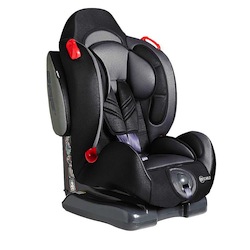Airbags Improve Safety
Airbags have become a standard feature of vehicles in recent years as safety standards have improved in all respects. Indeed, many manufacturers now install air bags above and beyond the standard required by national and EU directives, often including curtain airbags that inflate on the side of the vehicle. In the case of adults, air bags are almost always a help when it comes to saving lives and preventing serious injury following an accident.
Airbags and Child Seats
But with babies and young children using car seats the airbags are not always safe, so make sure you know the airbag configuration for your car, as well as what is and what is not acceptable. The most obvious danger reported by accident experts relates to parents that place their little one in a front passenger seat with an airbag. The problem here only occurs when children are placed in rear-facing seats. Crash tests show that these baby seats can be flipped backwards in the event of an accident due to the airbag inflating and pushing the baby headfirst back into the seat.
Avoid Airbags and Baby Seats

The general rule is therefore not to put your baby or young child in the front passenger area and to instead put them in either a rear-facing or front-facing car seat in the back of the vehicle that uses an ISOFIX attachment or can otherwise garner the necessary restraint from an adult belt.
Avoid Placing Child in Front Seat
Many parents seem to be tempted to put their kids in a car seat and then place them in the front passenger seat, but crash test research shows that even without the airbag problem, this tends to be less safe. Just because you can see your baby more easily doesn’t mean they will fare any better during a serious accident. This is why most manufacturers warn against placing children in the front seat. The airbag problem is just another issue that makes this set-up less than safe for your child.
Move Front Seat as Far Back as Possible
Even with forward-facing car seats, airbags can be a problem, meaning most experts advise not to place a child in such a situation unless absolutely necessary and, if so, it is advised that the front seat is moved back as far as possible. Indeed, air bags can also be dangerous for older children in the front seat that may be using a Group 2 seat. Even at the age of seven or eight, a child is much weaker in key areas, such as the back, neck and in relation to stomach muscles, all of which means it is harder for them to keep in an upright position during even the most gentle collisions.
Dangers from direct impact of an Airbag
This effect is further exacerbated by the relative size of a child’s head to its body, which is greater than it is for an adult. Therefore a child will struggle to deal with the blunt force of an airbag as it expands at speeds of up to 160 miles per hour. The general rule with air bags and car seats then is that you want to keep your child out of the direct impact of an airbag as it inflates.

 Audi 7-Seater
Audi 7-Seater BMW 7‐Seaters
BMW 7‐Seaters Chevrolet MPVs
Chevrolet MPVs Chrysler MPVs
Chrysler MPVs Citroen MPVs
Citroen MPVs Fiat 7-Seaters
Fiat 7-Seaters Ford 7-Seaters
Ford 7-Seaters Honda MPVs
Honda MPVs Hyundai MPVs
Hyundai MPVs Jeep 7-Seaters
Jeep 7-Seaters Kia 7-Seaters
Kia 7-Seaters Land Rover
Land Rover Mazda MPVs
Mazda MPVs Mercedes MPVs
Mercedes MPVs Mitsubishi
Mitsubishi Nissan
Nissan  Peugeot
Peugeot  Renault
Renault  SEAT 7‐Seaters
SEAT 7‐Seaters Ssangyong
Ssangyong  Toyota
Toyota  Vauxhall MPVs
Vauxhall MPVs Volkswagen
Volkswagen Volvo MPV
Volvo MPV All Manufacturers
All Manufacturers